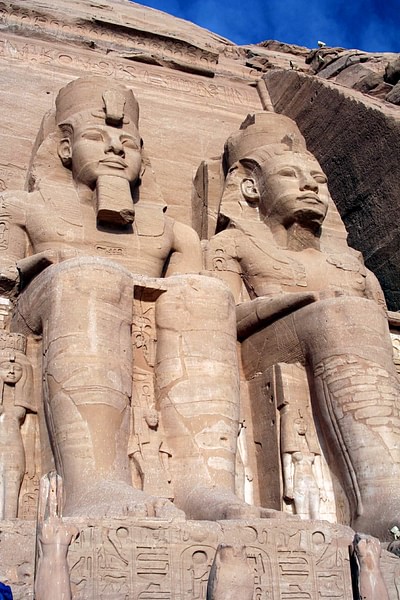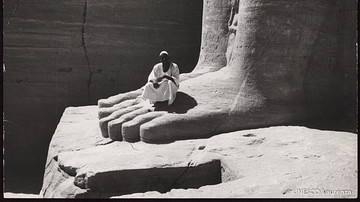Her name echoes down the corridors, in classrooms and in books, Christiane Desroches Noblecourt was a great French Egyptologist and, in the opinion of the writer, a woman strong and determined enough to have been the first female to direct an excavation in 1938 and afterwards, in 1960, possibly the most epic archaeological undertaking of all time.
Acting as an arbitrator during the Cold War, Christiane was able to bring together 50 countries for one purpose, was able to find the funding and bring together the best team to cope with the incredible and monumental rescue of Abu Simbel, operation that would cost more than $40 million dollars at the time.
To the south of Egypt on the border with Sudan, the area of Abu Simbel contains dozens of archaeological sites. In 1960 with the construction of the Aswan dam and its artificial water supply, these sites were in danger of being drowned and lost forever.
The dam, built to control flooding of the Nile, is an extension of the previous basin which was not sufficiently large for the needs of the country. The new Great dam would create a reservoir (Lake Nasser) large enough to provide electricity to half of the country. This new lake, however, alarmed archaeologists who immediately realized the danger that the much-needed reservoir would create for archaeological sites, whose future would at best be one of complete obliteration.
All this did not happen because fortunately, Christiane's voice was heard, when doubts were raised over the dangers, Christiane was commissioned by UNESCO to take a census of all sites at risk of flooding, but she did not stop there, the number of endangered sites was too high, the importance of some of these led her to embark on a crusade, a race against the clock and all other obstacles to saving those sites.
She found financial backers and architects and smoothed the path to meetings with the archaeologists, but most especially she promoted the “ idea” of saving the endangered archaeological sites. The basin was ready and the dam project well under way. In journalism we often write about a “big project, “translation”, “bailout”, ”translocation”, or “relocation”, but in my opinion none of these words adequately describe the extent of the toil that was needed in order to save the temples, which were tens of meters high, carved into the rock, fragile and precious as the finest crystal. But between 1964 and 1968, the temples were completely cut into large blocks (weighing from 20 to 30 tons) dismantled, reassembled and raised to a new location 65 meters higher and 300 meters back from the river bank, with the labour of more than two thousand workers, led by a group of Italian quarrymen, experts in marble from Carrara, in an unprecedented technological effort. They faced one of the greatest challenges in the history of archaeological engineering.
And don't think that the decision to dissect the statues was easy to make. It was an anguished decision, deeply discussed and debated and there were probably quite a few archaeologists who wept over it. It might be said today that they could have done it differently, but for me it makes no difference, what mattered was: mission accomplished.
From the engineering point of view, the mode of transport was resolved, the new installation was defined with the domes of cement that would give shape to the hills on which the temples were to be supported, but the point to consider now is that of the archaeologists who in addition to checking that nothing was ruined by a little clumsy laboring, pledged to restore the balance between the original siting of the temples and the new installation.
In this regard, the archaeologists made the decision to be consistent with that which they had to do, and chose not to consider transport as simply a fortuitous rescue to save only the material wealth of archaeological sites that were in danger, but they also made the commitment to “carry” the cult of the temple, to move it whilst honouring the fundamental reason why the temple was in that exact position in the first place.
I'm talking about the celestial phenomenon, which makes provision for the exact dates and precise times, when the sun's rays slant into the temple to illuminate the great room and the pharoah's stone effigies, gilded by the divine rays of the living Sun.
Built during the reign of Ramses II (1265 BCE) , the great temple is the largest in the area and the largest to have been moved, and is dedicated to the gods Amun, Ra-Horakhty, Ptah and Ramses himself. To build it took twenty years of hard work not only in architecture alone.
The architects of ancient Egypt aligned the temple so that , on October 21 and February 21 (61 days before and 61 days after the winter solstice), the sun's rays enter into the sanctuary to illuminate the sculptures on the wall, except for the statue of Ptah, the god associated with the underworld, which remains in shadow.
From studies done, but still very theoretical, the dates should match the king's birthday and coronation day, but there is no evidence to support this except the fact that if the sun is permitted to enter on those two particular dates it is for a significant purpose.
The light enters and illuminates the statues, the rays are directed primarily on the statue of Ramses. The power of the sun recharges and revitalizes him, beside him Amon Ra and Ra-Horakhty are also partially illuminated and Ptah is the god of darkness beside them perfectly in the shade.
The effort , in moving the temple, to be able to fully replicate the event, however, led to a margin of error of one day (forward) compared to the original dates, creating controversy and a regretful postscript to this otherwise so perfectly successful saga. But bearing in mind all the commitment shown by the people who contributed to the rescue, it should not be subjected to controversy but only relief and gratitude, as fate has decreed that the temples, though not yet a world heritage site, were later to become one at the completion of the work in their new location.
One could almost hope that somewhere, Ramses II and his wife, Queen Nefertari, are nodding their heads in thoughtful approval, he of the saving of the temple, she of the strength and initiative of a member of her sex.
There are those born a few centuries ago, who would have liked to have lived at the time of the great Roman emperors, or in XVII century. I wish I had been born at the time of Christiane Desroches Noblecourt, an Egyptologist and an archaeologist who died in July of this year and is now being commemorated by archaeologists, scholars and by the great centers of archaeological studies as an advocate of one of the largest and most impressive archaeological works ever undertaken, the first woman in history to lead an excavation, curator of the Louvre, Christiane, who together with the Minister of Egyptian cultural heritage shared with the world what they were able to save, leaving to the museums of the world the images of Abu Simbel and its temples, telling the story of what they have done as a duty and not just as a part of a job.
She led the people of France to launch an appeal to the reluctant and indifferent world, a plea for help, launched jointly with the then incumbent French Minister of Cultural Affairs , Andre Malraux: “The power that created the colossal monuments threatened today. . . speaks to us in a voice as exalted as that of the architects of Chartres, as that of Rembrandt. . .Your appeal is historic, not because it proposes to save the temples of Nubia, but because through it the first global civilization publicly claims the world's art as its indivisible heritage. . .There is only one action over which the indifference of stars and the eternal murmuring of rivers have no sway - it is the act by which man snatches something from death.”
She, who in front of the General Charles de Gaulle, was unimpressed when he at first did not understand what Christiane had set in motion and said: “Mais enfin, Madame, comment avez-vous osé dire que la France sauverait le temple, sans avoir été habilitée par mon gouvernement? ” and replied “Et comment, Général, avez-vous osé envoyer un appel à la radio, alors que vous n'aviez pas été habilité par Pétain? “.
I would have liked to be born at the time of Christiane Desroches Noblecourt and to have responded to her call for help.








